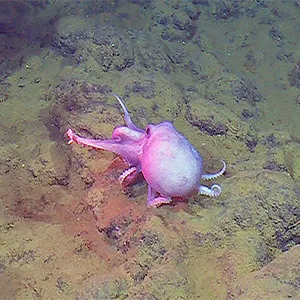
Deep sea octopus footage could revolutionize flexible robot design
A new camera system called EyeRIS has captured crisp three-dimensional footage of deep-sea octopuses crawling almost two miles below the surface.
The images reveal subtle bends and strains in each arm, data that engineers hope will guide the next wave of flexible machines.
Researchers filmed the animals at Octopus Garden, a nursery site that hosts about 6,000 brooding pearl octopuses on a warm patch of seafloor near Central California.
Principal Engineer Kakani Katija and Senior Research Specialist Crissy Huffard, both with the Monterey Bay Aquarium Research Institute (MBARI), led the study.
Filming deep-sea octopuses
EyeRIS rode on a remotely operated vehicle during dives to roughly 9,850 ft, a zone too dark for sunlight yet rich with life.
Because the system works in low light, it left the octopuses undisturbed, no bright lamps or tether lines altered their behavior.
The camera delivered real-time models of each animal’s posture, letting scientists tag and follow individuals over boulder fields.
Those models stream to the surface ship through fiber-optic cable, so the team can adjust focus and angle on the fly.
Such immediate feedback matters when observations cost thousands of dollars per hour and harsh currents limit dive time.
By knowing exactly what the camera “sees,” pilots can linger on rare actions like mating dances or defensive color flashes.
How EyeRIS sees in 3D
At the heart of EyeRIS sits a dense microlens array that captures dozens of perspectives in a single shot, a principle known as light-field imaging.
Software then stitches those perspectives into one frame where every pixel is sharp, even when subjects dart across uneven terrain.
That sharpness lets algorithms plot the octopus’s arm skeleton, frame by frame, without attaching markers or probes.
The approach contrasts with laboratory studies that often require tanks or anesthetized animals, settings that miss natural movements.
Engineers built the housing from titanium and acrylic to survive crushing pressures and icy temperatures. The package weighs under 110 lbs, light enough for quick swaps between MBARI’s submersibles during routine maintenance.
Lessons from octopus arms
“These flexible joints concentrate and bend above and below a single point, giving the octopus simple yet elegant control,” explained Huffard.
EyeRIS data revealed that each arm forms temporary muscular “joints” which shift position as the animal crawls.
The finding supports earlier work showing that octopus arms act as muscular hydrostats, organs that stiffen without bones by selectively contracting fibers.
By localizing strain, the animal reduces the number of commands the brain must send, a form of biological efficiency.
“There was no need to bring animals to the lab, which keeps the behavior authentic,” said Katija. She noted that fine-scale maps of curvature came straight off the seafloor.
Robots, deep-sea octopus, biomimicry
Soft-robot designers crave blueprints for limbs that bend anywhere yet still push against the world. Light-field footage supplies those blueprints in millisecond increments, turning a mysterious crawl into numbers that code can mimic.
Early prototypes already pair silicone sleeves with pressurized chambers to copy the octopus gait. Future versions could inspect ship hulls, grip delicate coral, or thread wiring through collapsed buildings.

Because the control scheme looks simplified, software may run on low-power chips rather than bulky processors. That shift could lower costs and widen adoption in medicine, manufacturing, and search-and-rescue.
Protecting hidden ecosystems
The Octopus Garden sits inside the Monterey Bay National Marine Sanctuary, an area under consideration for stricter protections as deep-sea mining expands.
Non-invasive tools like EyeRIS strengthen conservation arguments by proving that fragile nurseries thrive in seemingly barren depths.
Long time-series footage will also track how warming currents affect brooding success, egg development, and predator visits.
Such baseline data barely exist for most abyssal species, leaving policymakers with little guidance on cumulative impacts.
MBARI plans to release segments of the footage to educators and documentary crews. Seeing a pearl octopus hustle across 35°F mud may kindle public interest in preserving regions far beyond human sight.
EyeRIS and future missions
The David and Lucile Packard Foundation and the Gordon and Betty Moore Foundation financed the camera’s development.
Their grants covered custom optics, pressure testing, and the software pipeline that converts raw pixels into usable models.
“I’m excited to watch other labs adapt this technology for jellyfish, squid, and even plankton swarms,” said Katija. She went on to explain that the team is adding a spectral sensor to measure how skin pigments shift during motion.
The next deployment will explore hydrothermal seeps 60 miles offshore, places where methane bubbles lure both octopuses and crabs.
If EyeRIS can cope with shimmering hot fluids, its design could inspire cameras for Europa or Enceladus missions.
The study is published in Nature.
—–
Like what you read? Subscribe to our newsletter for engaging articles, exclusive content, and the latest updates.
Check us out on EarthSnap, a free app brought to you by Eric Ralls and Earth.com.
—–













